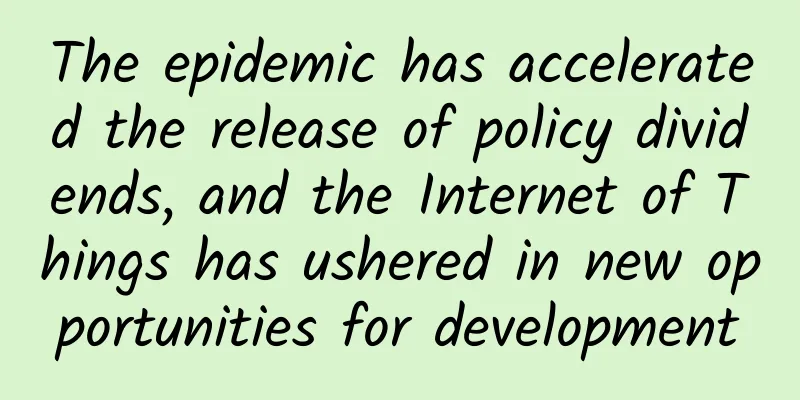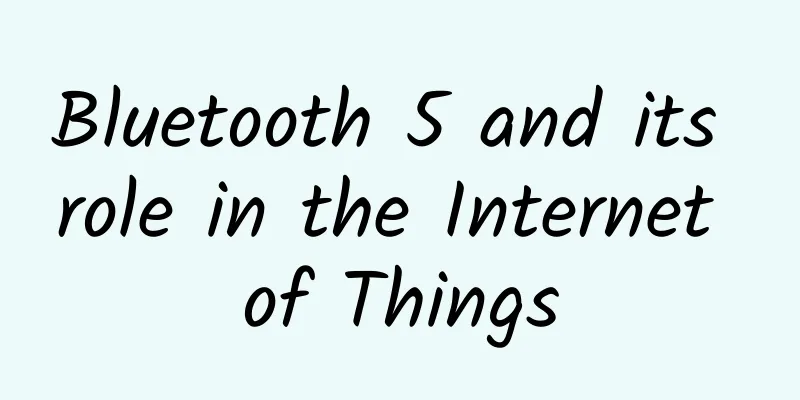The epidemic has accelerated the release of policy dividends, and the Internet of Things has ushered in new opportunities for development

|
Under the severe constraints of the COVID-19 epidemic, the global economic situation is not optimistic, and the country continues to introduce regulatory policies. The meeting of the Standing Committee of the Political Bureau of the CPC Central Committee held on March 4 emphasized the need to accelerate the construction of new infrastructure such as 5G, artificial intelligence, industrial Internet, big data, and new energy. Although the new infrastructure does not explicitly point out the Internet of Things, the essence of the Internet of Things is to achieve the connection between people and things, and things and things. The data collection and transmission of the new infrastructure cannot be separated from the Internet of Things. The essence of this new infrastructure is to subdivide the application of the Internet of Things into various fields, and the Internet of Things is everywhere. Today, we will explore new opportunities for the Internet of Things in the context of policy dividends and the COVID-19 pandemic: What’s the connection between 5G and IoT? 5G and the Internet of Things complement each other. The Internet of Things is an ever-growing physical network that connects any object to the Internet through various sensor devices to achieve information interaction. It has the ability to collect and share large amounts of information data and the need for massive connections. For example, the Internet of Things turns every link and equipment in the production process into a data terminal, collects underlying basic data in all directions, and conducts deeper data analysis and mining, thereby improving efficiency and optimizing operations. In different connection scenarios, the Internet of Things has stringent requirements on speed and latency, and requires an efficient network foundation to fully realize its potential.
5G has three major characteristics: large capacity, high speed, and low latency. Compared with 4G, it has more powerful communication and bandwidth capabilities, and can meet the needs of IoT applications such as high speed, stability, and wide coverage. The popularization of 5G will accelerate the implementation of IoT applications that are still in the theoretical or pilot stage. From the perspective of industrial development, the Internet of Things has successfully passed the industrial introduction period and entered a period of rapid growth. From the perspective of demand and market space, with technological progress and policy support, China's Internet of Things industry space is gradually opening up. According to data from the Ministry of Industry and Information Technology, the industry scale reached 750 billion yuan in 2015, a year-on-year increase of 29.3%; by 2020, the overall scale of China's Internet of Things will exceed 1.8 trillion yuan. What impact has the COVID-19 pandemic had on the IoT application market? The "war against the epidemic" in 2020 has once again brought telemedicine, AI infrared temperature measurement, and unmanned delivery back into the public eye, and has also once again prompted us to think about the construction of smart factories, smart medical care, smart logistics, and smart cities. 1. The manufacturing industry faces "difficulties at the beginning" and accelerates the process of intelligentization The COVID-19 pandemic has had a profound impact on all industries, especially the manufacturing industry. A large number of workers are unable to return to work as scheduled, and small and medium-sized manufacturing companies are facing the "difficulty of starting" in 2020 - difficulty in resuming work. According to public data from the Ministry of Industry and Information Technology, as of February 26, 2020, the resumption rate of small and medium-sized enterprises nationwide was only 32.8%. Under the epidemic, applications such as production automation and remote operation and maintenance have greatly enhanced the survival of enterprises. The more intelligent the enterprise is, the stronger its ability to resist risks. For example, companies such as Foxconn and BYD have more advanced intelligent factories or automated production lines. They are less dependent on manual labor and have the ability to quickly integrate resources to switch to the production of masks. In smart factories, the Industrial Internet of Things, by leveraging its characteristics of comprehensive perception, reliable transmission, and intelligent processing, can achieve smart factory production process detection, real-time data collection, and monitoring and management of production equipment and products, allowing resources to be used more efficiently. The epidemic has further increased Chinese companies' awareness of the Industrial Internet of Things and smart manufacturing. Traditional manufacturing industries will be more proactive in thinking about and paying attention to the intelligent construction of factories and promoting the application of automated production lines. It is estimated that by 2025, about 70,000 factories will adopt smart IoT applications, and more than 6.3 million employees will benefit from safe production and reduced operating load. (Data source: iResearch Consulting) 2. The lack of information sharing and intelligence in the medical industry is exposed The medical system includes functional agencies such as the National Health Commission, medical institutions (such as hospitals), and public health service agencies (such as the Centers for Disease Control and Prevention). These agencies use their own information platforms to collect and manage data. For reasons such as privacy protection, there is no connection between the platforms and data cannot be shared. The Medical Internet of Things effectively eliminates information islands between platforms.
The epidemic has developed into a global public health event. The full outbreak of demands for online consultations, remote collaboration, etc. has allowed us to see the core of medical issues - the coordination and sharing of medical resources, which may be a key factor in promoting the development of the Medical Internet of Things. As various medical devices become part of the Internet of Things, services in the medical field will also be improved. The current problems in my country such as uneven distribution of medical resources and difficulty in seeking medical treatment across regions will also be solved. 3. Smart cities face the challenge of breaking down data barriers and achieving data connection and sharing During the epidemic, how to quickly and accurately screen and locate every suspected new coronavirus pneumonia patient, as well as the whereabouts of suspected infected persons and close contacts, has become a test question for smart cities. During this epidemic, the AI infrared video automatic temperature measurement system based on the Internet of Things technology was widely used for the first time in places with dense population flow, such as customs, airports, and hospitals. When a suspected person appears, it will automatically alarm, realizing nationwide online monitoring and early warning. In addition, the city's "Xueliang Project" has become a "clairvoyant" for epidemic prevention and control. Relevant departments have implemented 24-hour "human + machine" monitoring without blind spots through the "Xueliang Project" monitoring system to ensure that the movement of people is not missed. Despite the support of high-tech, smart cities have not performed well during the epidemic, and there are still problems such as cross-regional linkage and resource scheduling. Therefore, breaking down data barriers between cities and realizing real-time data connection and sharing is the future direction of smart city improvement. 4. The logistics industry is accelerating the commercial process of comprehensive intelligent development During the epidemic, all major supermarkets, department stores, and vegetable markets across the country stopped operating, and online shopping became the preferred channel for residents to purchase daily necessities. However, due to the unsatisfactory resumption rate of express delivery companies, the shortage of logistics delivery personnel, and the high risk of infection during the delivery process, the logistics industry is facing huge challenges. In order to effectively protect the life, health and safety of delivery personnel and solve the problem of personnel shortage, robots are used to complete the last mile of delivery in Hubei. This unmanned delivery based on communication and artificial intelligence technology effectively solves the above problems. The COVID-19 pandemic has brought unmanned delivery based on IoT communication technology and artificial intelligence technology back into the public eye, and has also accelerated the commercial process of comprehensive intelligent development of logistics. In the future, logistics companies may use IoT technology to conduct road tests in complex scenarios, improve the stability of the unmanned delivery process, and reduce the production cost of hardware products. Conclusion: During this COVID-19 pandemic, we have seen new challenges and new demands for the construction of the Internet of Things in industries such as manufacturing, medical care, logistics, and smart cities. It has also, to some extent, increased the country's and the general public's awareness and attention to the Internet of Things, which will further give rise to new application scenarios for the Internet of Things. In the future, with the support of artificial intelligence and 5G technology, IoT scenario applications will be fully intelligent, helping various industries to further integrate development resources and achieve resource sharing and business collaboration. |
<<: 5G speed may be slower than 4G?
>>: 8 ways businesses are using technology and tools for remote meetings
Recommend
Shengye: Equipping "engineering projects" with a digital brain
The construction industry is an important pillar ...
Telecommunications Unions always merge when things get tough: the operator version of "The Wolf is Coming"
I wonder if you have noticed this strange phenome...
South Korean operator SKT invests $100 million in OpenAI competitor to develop large-scale AI models for the telecommunications industry
The trend of big AI models has reached the teleco...
HostingViet: 35% off for annual VPS/virtual hosting in Vietnam, 35% off for new purchases of Email Server
HostingViet's April promotion will end in two...
inetWS: $2/month KVM-2GB/30G SSD/100M unlimited traffic/7 data centers in Seattle, Phoenix, Chicago, etc.
inet.WS is a foreign hosting company founded in 2...
HostDare: $15.56/half year-756MB memory/35GB hard disk/600GB monthly traffic/Los Angeles data center
HostDare has launched this month's promotion,...
OpLink: Houston 1Gbps unlimited traffic high-security VPS starting at $1 for the first month
Tribe has shared information about OpLink twice i...
Just now: The Ministry of Industry and Information Technology requires the three major operators to conduct self-inspection of their "unlimited" packages!
The entire industry should immediately conduct se...
How 5G, edge computing, and IoT can modernize traditional enterprises
Over the past two years, the global pandemic and ...
The Evolution of Hybrid Workplace Networking
The past few months have significantly changed th...
The pain of transformation in the gaming industry is evident as Digital Sky successfully breaks through with the help of Huawei Cloud
[51CTO.com original article] In 2017, the total r...
[Black Friday] Zgovps: $12.9/year-1GB/20GB/2TB/Japan IIJ/Germany/Los Angeles AS4837, etc.
Zgovps also released a promotion during this year...
6GHz band officially approved, Wi-Fi 6E to debut this year: 2.5 times faster
Since the Wi-Fi frequency band was first vacated ...
DogYun celebrates the 25th anniversary of Hong Kong's return to China. Hong Kong server is available for 2 months at 450 yuan, dual E5/32G/1TB SSD/20M bandwidth
DogYun has launched a special promotion for the 2...
RackNerd Spring Festival Promotion: KVM annual payment starts at $13.99, 1.5GB/20GB/3TB/multiple computer rooms
RackNerd is a foreign VPS hosting company founded...









